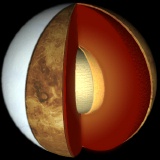 |
|||
|
Three views of Venus
|
|||
| VENUS - THE MORNING STAR | |||
| Venus is the third brightest object in the night sky (the Sun and Moon are brighter). The brightness of Venus often causes people to believe it to be an artificial light source, and consequently Venus is the cause of many UFO sightings. | |||
| Venus orbits closer to the Sun than does Earth, and therefore when viewed from Earth is always seen near the Sun. Venus is therefore best seen near sunrise and sunset. | |||
| Being such a bright object, Venus was known to ancient civilisations, including for example the Chinese, Mesopotamians and Babylonians. | |||
| Before the discoveries made by spacecraft, Venus was regarded as Earth's twin, possibly even being home to an alien civilisation living in a paradise-like environment. | |||
| Orbit | |||
| Venus orbits the Sun at an average distance of 108 million kilometres, in an orbit that is nearly a perfect circle. Travelling at a speed of 35 kilometres per second, Venus completes one orbit in nearly 225 days. This is the length of the Venusian year, but Venus is unusual in that it rotates on its axis once in 243 days. That is, the Venusian day is longer than the Venusian year. Furthermore, the rotation of Venus is retrograde. | |||
| The orbit of Venus lies within the orbit of Earth, and consequently Venus exhibits phases as seen from Earth. This observation was noted by Galileo, and indeed keen-sighted people can see the phases of Venus without the use of a telescope. | |||
| Our sister planet? | |||
| With a similar density, size, and mass, Venus has often been called Earth's sister planet. Such similarities have been used in the past to suggest that Venus is an Earth at an early evolutionary stage. | |||
 Venus compared to Earth. |
|||
| Surface | |||
| The Venusian surface was mapped in great detail by the Magellan spacecraft, revealing a very complex surface, and showing Venus to be a world of extremes. Over a thousand volcanic constructs were revealed by Magellan's radar for the very first time - some of the volcanoes of a type seen nowhere else in the Solar System. | |||
| The Venusian surface was mapped in great detail by the Magellan spacecraft, revealing a very complex surface, and showing Venus to be a world of extremes. Over a thousand volcanic constructs were revealed by Magellan's radar for the very first time - some of the volcanoes of a type seen nowhere else in the Solar System. | |||
| The Venusian surface | |||
| A similar core to Earth | |||
| Spacecraft measurements suggest that Venus has a core similar in size to Earth's core, made of iron, with an overlying mantle. Similar to Earth, Venus may have also have convection currents in the mantle. However, the evolution of Venus appears to have been dramatically different. | |||
 The interior of Venus. |
|||
| More on the evolution of Venus | |||
| Weak magnetic field | |||
| If Venus has a magnetic field it is exceptionally weak. Given the very slow rotation rate of Venus (243 days), this is to be expected. The rotation rate is too slow to allow the generation of a magnetic field in the planet's metal core. | |||
| Shrouded in mystery? | |||
| Venus is shrouded in a thick opaque atmosphere that prevents telescopic observation of the surface of Venus, allowing science fiction for many years to propose an alien civilisation living on a surface with abundant vegetation, and even Venusian oceans. | |||
| Spacecraft missions have revealed the true nature of the atmosphere and surface. The depth and density of the atmosphere creates a pressure on the surface of Venus 90 times greater than Earth's atmospheric pressure - intolerable to humans. | |||
| The thick atmosphere acts as a thermal blanket, trapping heat and raising the temperature to over 450C - hot enough to melt lead. This process, known as the "greenhouse effect", was recognised on Venus before becoming an environmental issue on Earth. Does the atmosphere of Venus represent a possible future Earth? | |||
| More on the atmosphere and weather of Venus | |||
| Volcanoes | |||
| Venusian volcanoes come in a variety of shapes and sizes, ranging from small cones to huge shield volcanoes, and including "pancake" domes. Mixed with the volcanoes are large lava flows and long lava channels - the longest channel in the Solar System can be found here. | |||
 Sapas Mons |
|||
| More on Venusian volcanoes, flows, and channels. | |||
| Crowns and spiders | |||
| Some of the volcanic features on Venus are unique - the Venusian surface exhibits a range of features, coronae and arachnids (crowns and spiders), that are not to be found on any other moon or planet. | |||
 Corona on Venus. |
|||
| More on the crowns and spiders of Venus | |||
| Craters | |||
| Like all the rocky bodies of the Solar System, Venus too has its share of impact craters. However, Venus appears to be missing the usual range of smaller craters. Furthermore, the craters all have the appearance of being new - what does this say about the Venusian surface? | |||
 Crater on Venus. |
|||
| Exploration of Venus | |||
| After the Moon, Venus is the most visited object in the solar system. But although early spacecraft flew by Venus, the surface remained elusive, hidden by a soupy atmosphere. The exploration of Venus made its greatest advance with the Magellan mission and the return of detailed radar pictures. | |||
| More on the exploration of Venus | |||
|
|
|||